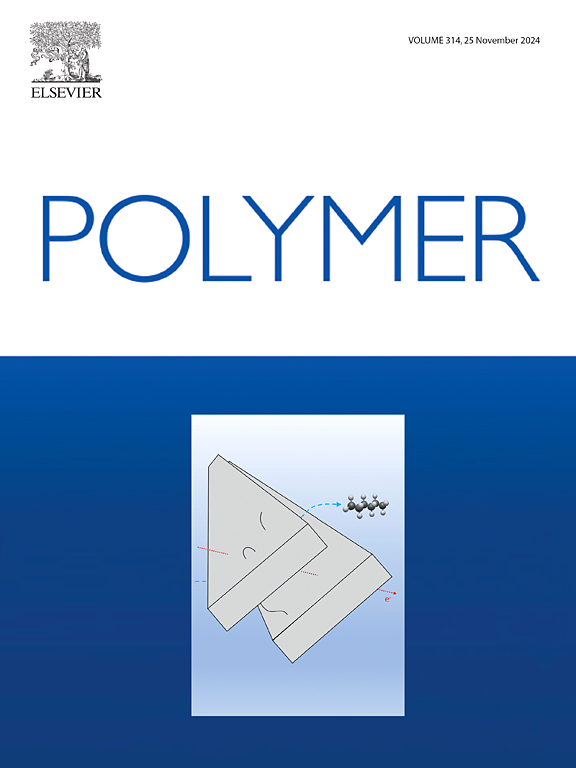利用raft合成的甲基丙烯酸酯制备表面工程六方氮化硼,增强其在蓖麻油中的分散性和摩擦学性能
IF 4.5
2区 化学
Q2 POLYMER SCIENCE
引用次数: 0
摘要
六方氮化硼(h-BN)具有较高的热稳定性和化学惰性,是一种很有前途的固体润滑剂和石油添加剂;但其在非极性介质中的分散性差,限制了其实际应用。在本研究中,采用单体水平的疏水设计策略来克服这一问题。用戊酸、月桂酸或棕榈酸对甲基丙烯酸2-羟乙基酯(HEMA)进行Steglich酯化反应,然后用羧基功能链转移剂进行RAFT聚合,合成甲基丙烯酸单体。所得到的均聚物被共价接枝到羟基化的h-BN纳米片上,从而产生具有定制疏水侧链的杂化纳米结构。结构分析证实了接枝后形成了定义良好的聚合物,并保留了h-BN的层状结构。在蓖麻油中进行的为期21天的分散试验表明,短链聚合物增强了稳定性,而长链聚合物由于疏水聚集而导致沉淀。在边界润滑下,使用球盘摩擦计评估了摩擦性能。分析了摩擦系数、磨损率和磨损形态。值得注意的是,与纯蓖麻油相比,聚甲基丙烯酸月桂酯接枝的h-BN获得了最低的稳态摩擦系数(0.0646)和磨损率(0.01132 mm3/N·m),相应的摩擦降低了59%,磨损降低了86%。这些改进归功于油相容性、界面附着力和摩擦膜形成的改善。该研究展示了聚合物设计如何控制分散性和摩擦学行为,为工程油兼容二维润滑剂添加剂提供了一种可扩展的方法。本文章由计算机程序翻译,如有差异,请以英文原文为准。


Surface-engineered hexagonal boron nitride via RAFT-synthesized methacrylates for enhanced dispersibility and tribological performance in castor oil
Hexagonal boron nitride (h-BN) is a promising solid lubricant and oil additive due to its high thermal stability and chemical inertness; however, its poor dispersibility in non-polar media limits practical use. In this study, a monomer-level hydrophobic design strategy was employed to overcome this issue. Methacrylate monomers were synthesized by Steglich esterification of 2-hydroxyethyl methacrylate (HEMA) with pentanoic, lauric, or palmitic acid, followed by RAFT polymerization using a carboxyl-functional chain transfer agent. The resulting homopolymers were covalently grafted onto hydroxylated h-BN nanosheets to yield hybrid nanostructures with tailored hydrophobic side chains. Structural analysis confirmed the formation of well-defined polymers and preservation of h-BN's layered structure after grafting. Dispersion tests in castor oil over 21 days revealed that short-chain polymers enhanced stability, while long chains led to sedimentation due to hydrophobic aggregation. Tribological performance was evaluated under boundary lubrication using a ball-on-disc tribometer. Friction coefficients, wear rates, and wear morphologies were analyzed. Notably, h-BN grafted with poly(lauryl methacrylate) (PLAMA) achieved the lowest steady-state friction coefficient (0.0646) and wear rate (0.01132 mm3/N·m), corresponding to 59 % reduction in friction and 86 % in wear compared to neat castor oil. These improvements are attributed to improved oil compatibility, interfacial adhesion, and tribofilm formation. This study demonstrates how polymer design governs dispersion and tribological behaviour, offering a scalable approach to engineering oil-compatible 2D lubricant additives.
求助全文
通过发布文献求助,成功后即可免费获取论文全文。
去求助
来源期刊

Polymer
化学-高分子科学
CiteScore
7.90
自引率
8.70%
发文量
959
审稿时长
32 days
期刊介绍:
Polymer is an interdisciplinary journal dedicated to publishing innovative and significant advances in Polymer Physics, Chemistry and Technology. We welcome submissions on polymer hybrids, nanocomposites, characterisation and self-assembly. Polymer also publishes work on the technological application of polymers in energy and optoelectronics.
The main scope is covered but not limited to the following core areas:
Polymer Materials
Nanocomposites and hybrid nanomaterials
Polymer blends, films, fibres, networks and porous materials
Physical Characterization
Characterisation, modelling and simulation* of molecular and materials properties in bulk, solution, and thin films
Polymer Engineering
Advanced multiscale processing methods
Polymer Synthesis, Modification and Self-assembly
Including designer polymer architectures, mechanisms and kinetics, and supramolecular polymerization
Technological Applications
Polymers for energy generation and storage
Polymer membranes for separation technology
Polymers for opto- and microelectronics.
 求助内容:
求助内容: 应助结果提醒方式:
应助结果提醒方式:


